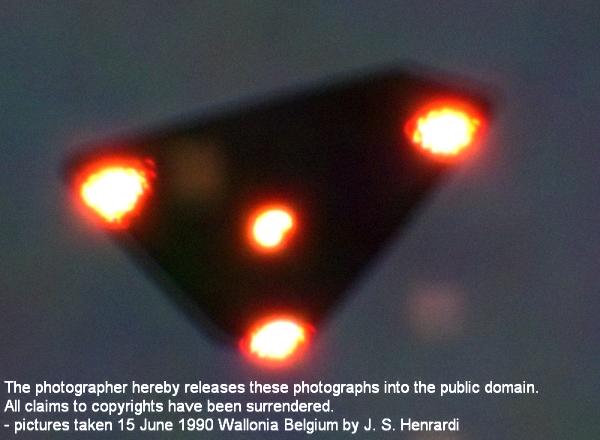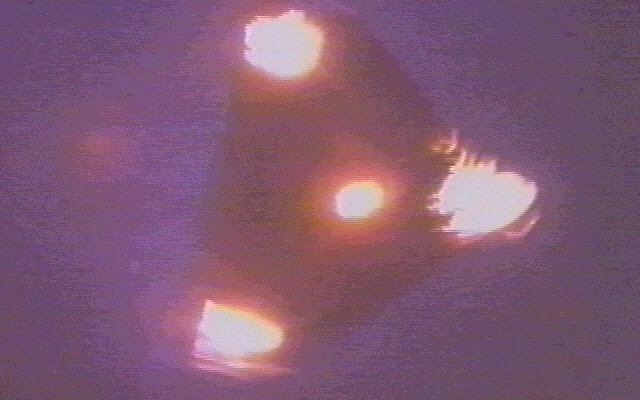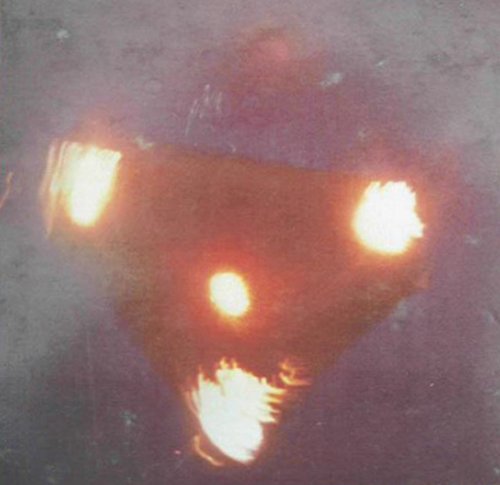The Belgian UFO wave peaked with the events of the night of 30/31 March 1990. On that night unknown objects were tracked on radar, photographed, and were sighted by an estimated 13,500 people on the ground – 2,600 of whom filed written statements describing in detail what they had seen.[1] Following the incident the Belgian air force released a report detailing the events of that night.
At around 23:00 on 30 March the supervisor for the Control Reporting Center (CRC) at Glons received reports that three unusual lights were seen moving towards Thorembais-Gembloux which lies to the South-East of Brussels. The lights were reported to be brighter than stars, changing color between red, green and yellow, and appeared to be fixed at the vertices of an equilateral triangle. At this point Glons CRC requested the Wavre gendarmerie send a patrol to confirm the sighting.
Approximately 10 minutes later a second set of lights was sighted moving towards the first triangle. By around 23:30 the Wavre gendarmerie had confirmed the initial sightings and Glons CRC had been able to observe the phenomenon on radar. During this time the second set of lights, after some erratic manoeuvres, had also formed themselves into a smaller triangle. After tracking the targets and after receiving a second radar confirmation from the Traffic Center Control at Semmerzake, Glons CRC gave the order to scramble two F-16 fighters from Beauvechain Air Base shortly before midnight. Throughout this time the phenomenon was still clearly visible from the ground, with witnesses describing the whole formation as maintaining their relative positions while moving slowly across the sky. Witnesses also reported two dimmer lights towards the municipality of Eghezee displaying similar erratic movements to the second set of lights.
Over the next hour the two scrambled F-16s attempted nine separate interceptions of the targets. On three occasions they managed to obtain a radar lock for a few seconds but each time the targets changed position and speed so rapidly that the lock was broken. During the first radar lock, the target accelerated from 240 km/h to over 1,770 km/h while changing altitude from 2,700 m to 1,500 m, then up to 3,350 m before descending to almost ground level – the first descent of more than 900 m taking less than two seconds. Similar manoeuvres were observed during both subsequent radar locks. On no occasion were the F-16 pilots able to make visual contact with the targets and at no point, despite the speeds involved, was there any indication of a sonic boom. Moreover, narrator Robert Stack added in an episode of Unsolved Mysteries, the sudden changes in acceleration and deceleration would have been fatal to one or more human pilots.
During this time, ground witnesses broadly corroborate the information obtained by radar. They described seeing the smaller triangle completely disappear from sight at one point, while the larger triangle moved upwards very rapidly as the F-16s flew past. After 00:30 radar contact became much more sporadic and the final confirmed lock took place at 00:40. This final lock was once again broken by an acceleration from around 160 km/h to 1,120 km/h after which the radar of the F-16s and those at Glons and Semmerzake all lost contact. Following several further unconfirmed contacts the F-16s eventually returned to base shortly after 01:00.
The final details of the sighting were provided by the members of the Wavre gendarmerie who had been sent to confirm the original report. They describe four lights now being arranged in a square formation, all making short jerky movements, before gradually losing their luminosity and disappearing in four separate directions at around 01:30.[2]
Photograph
 |
A supposed black
triangle, 15 June 1990, Wallonia, Belgium.
Claimed to have been taken during the UFO
wave, though released thirteen years
later.Wallonia, Belgium, Europe. Source
- Author J.S. Henrardi
Sceptics say there is no background in the photograph and that there is no element which would allow the calculation of the object's size or distance from the camera. Wim van Utrecht, a Belgian sceptic, has reproduced a copy of the photograph with devices. A computer graphics simulation method[4] to reproduce the photograph was developed by a Belgian mathematician, Thierry Veyt at The University of Liège Laboratory of Astrophysics, wherein the apparent "shake" motion, that results in the lights of the craft appearing blurred or out of focus in the photograph contradicts eye-witness statements. This, along with the anonymity of the photographer and fact that the image was not produced publicly until 4 months after the alleged event brings the authenticity of the image into question.[5]
Skeptical explanations
In The Belgian UFO Wave of 1989–1992 – A Neglected Hypothesis, Renaud Leclet & co. discuss the fact that some sightings can be explained by helicopters. Most witnesses reported that the objects were silent. This report argues that the lack of noise could be due to the engine noise in the witnesses' automobiles, or strong natural wind blowing in the direction of a witness, combined with the wind due to driving a vehicle.[6]
Books
UFOs above Belgium, written by John van Waterschoot, mathematician, economist and professor at the University of Leuven. Published by Lannoo.
Vague OVNI sur la Belgique (UFO wave over Belgium), written by the defunct SOBEPS organisation.
See also
References- "'Sunday Express' article on Belgium UFO". Sunday Express. 17 September 1995
- "Report concerning the observation of UFOs in the night from March 30 to March 31, 1990 - ufoevidence.org"
- Pierre Magain et Marc Remy, Les OVNI : un sujet de recherche? , Physicalia Magazine, Vol. 15, n°4, pp. 311–318.
- Original paper given to the french newspaper Le Soir Illustré and reproduced by "Les repas ufologiques parisiens" a french ufo association Le flou de bougé de la photo de petit-rechain par la calcul matriciel - [PDF]Archived]
- Le Soir Illustré, Jean-Marc Veszely, Ovni: la retraite à cinquante ans ? belgian newspaper interviewing a mathematician about Ufos and the "photograph of Petit-Rechain"
- "The Belgian UFO Wave of 1989–1992 – A Neglected Hypothesis" - [PDF]Archived]




